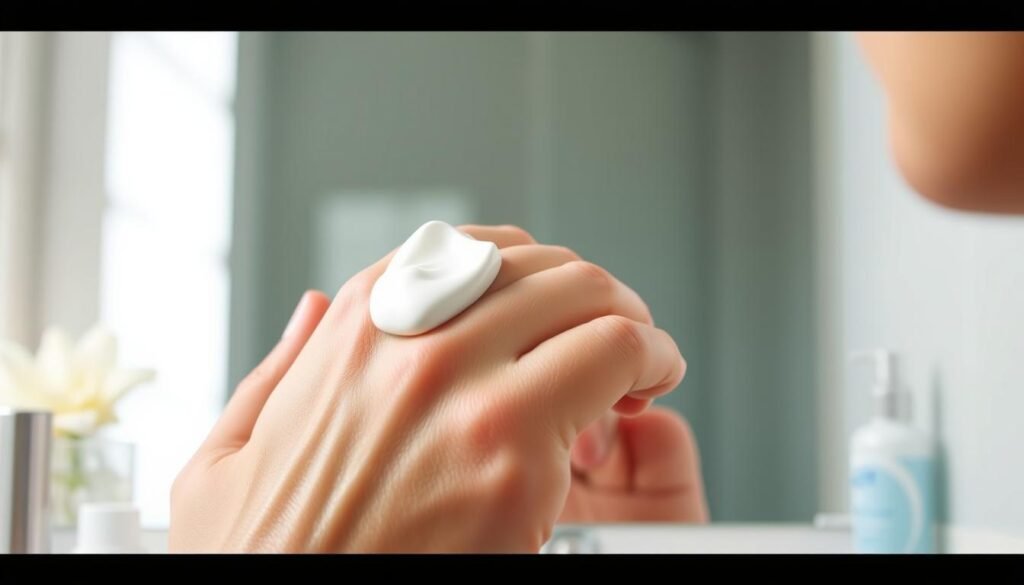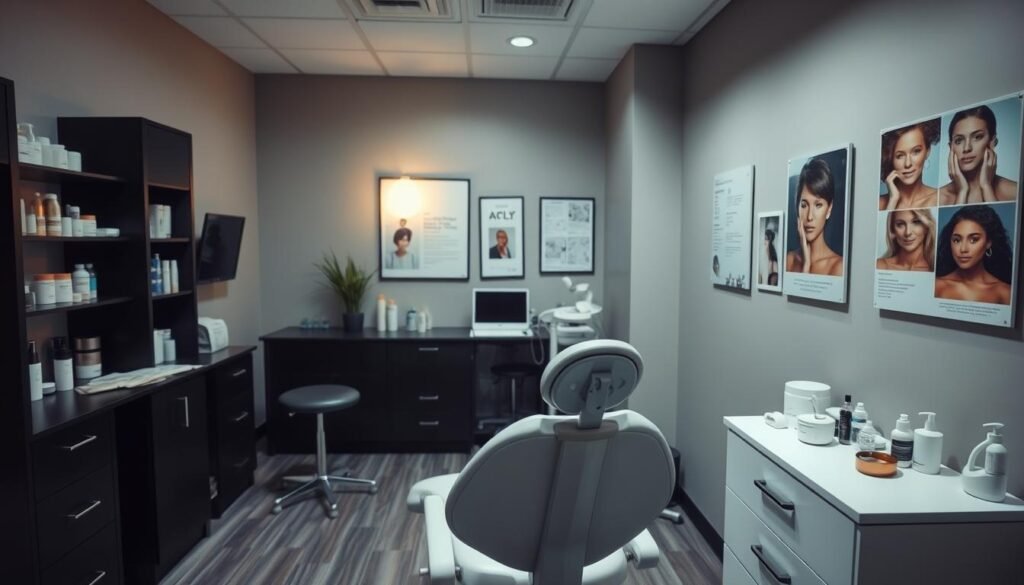Did you know that around 85% of young people between 12 and 24 deal with acne? It’s a widespread skin issue that varies from light to severe cases. Many are turning to benzoyl peroxide as a solution. Known for its power to combat acne, this agent comes in different forms like gels and cleansers. Here, we dive into how benzoyl peroxide helps, its working mechanism, and its popularity for achieving clear skin.
Key Takeaways
- Benzoyl peroxide is effective for treating mild to moderate acne and comes in various concentrations.
- It may take up to six weeks to observe the full effects of benzoyl peroxide treatment.
- Common side effects include dryness, redness, and skin irritation, especially when first using the product.
- It is crucial to consult a dermatologist if no improvement is seen after six weeks of use.
- Consistent application is essential for maintaining clear skin and preventing acne recurrence.
What is Benzoyl Peroxide?
Benzoyl peroxide is an organic peroxide known for treating acne well. It works as a strong oxidizing agent. By releasing oxygen onto the skin, it kills acne-causing bacteria like Propionibacterium acnes.
This ingredient fights acne in several ways. It has antimicrobial, anti-inflammatory, and comedolytic properties. Its effectiveness is why many skincare products use it. You may see improvements in acne after 3 to 4 weeks. The best results often show up after 8 to 12 weeks.
Brands like Acne Medication, Neutrogena Acne Cream, and Clearasil use benzoyl peroxide. Remember, it’s only for use on the skin, not for eating.
How Does Benzoyl Peroxide Work for Acne?
Benzoyl peroxide is a strong option for fighting acne bacteria and handling different acne types. It works through a complex benzoyl peroxide mechanism. This includes killing bacteria, reducing swelling, and helping skin shed dead cells. These actions together help lessen acne spots.
It attacks the growth of acne bacteria head-on. Benzoyl peroxide stops bacteria from growing and lowers redness and swelling, thanks to its anti-inflammatory properties. This stops acne’s cycle: bacteria growth, dead skin clogging pores, and too much oil.
Studies have proven that benzoyl peroxide fights off acne, even types that are tough against antibiotics. Research suggests noticeable skin improvements in 8 to 10 weeks. It shows why being patient and regular with the treatment matters.
This method helps greatly with blackheads, whiteheads, and red pimples. If you want to learn more about fighting acne, check out various methods, including benzoyl peroxide. For more tips on treating acne and lifestyle tips for clearer skin, visit this guide.
Benzoyl Peroxide for Acne: Effectiveness on Different Types
Benzoyl peroxide is great for many acne types. It’s especially good for severe acne like pustules and cysts. It kills the acne-causing bacteria, making it a go-to for those with cystic acne. This way, it tackles hard-to-fight pimples.
It’s clear benzoyl peroxide can tackle severe acne well. However, it also works on blackheads and whiteheads, but not as strongly. Using it with products like adapalene can improve results. This combination can create a stronger acne-fighting routine.
Benzoyl peroxide comes in gels, creams, and washes. It’s easy to get and safe for everyone, including pregnant women and people with darker skin. Lower strengths start treatment gently, fitting different skin needs. But, it can dry out and irritate the skin. Always talk to a dermatologist before starting to use it. They can help you use it right and avoid side effects.
How to Use Benzoyl Peroxide for Acne Treatment
Knowing how to apply benzoyl peroxide right is key to fighting acne. It comes in strengths like 2.5%, 5%, and 10% to fit your skin’s needs. Over-the-counter options are best for light acne, while stronger ones need a prescription.
Follow these acne treatment guidelines closely:
- Start with a bit of benzoyl peroxide gel or wash, using it once a day.
- Increase to twice daily if your skin can handle it.
- Always wash your face well before applying for best results.
- Only put it on spots with acne and watch out for hair and clothes to avoid bleaching.
- Wear sunscreen since benzoyl peroxide makes your skin more sensitive to the sun.
Seeing results takes time; expect to wait eight to ten weeks for improvement. Your skin might get worse before it gets better. If there’s no change after twelve weeks, it might be time to see a doctor.

Stick with it without missing days for the best results. With the right steps and products, your skin can become clearer.
For tips on keeping acne away, visit these important tips.
Benzoyl Peroxide vs. Other Acne Treatments
To make good choices about skincare, it helps to know the differences between acne treatments. Comparing benzoyl peroxide to salicylic acid shows they each have special uses.
Benzoyl peroxide is great for fighting off red, pus-filled pimples. The American Academy of Pediatrics says it’s the best OTC option. Salicylic acid, on the other hand, is better for blackheads and whiteheads. It works by peeling off dead skin.
Here’s a breakdown of how benzoyl peroxide and salicylic acid differ and what they share:
| Characteristic | Benzoyl Peroxide | Salicylic Acid |
|---|---|---|
| Primary Use | Inflammatory acne (pustules) | Noninflammatory acne (blackheads, whiteheads) |
| Application Frequency | 1-2 times a day | Morning and night |
| Common Concentration | 2.5% to 10% | 0.5% to 5% |
| Safety During Pregnancy | Yes | Yes |
| Typical Side Effects | Dry skin, irritation, itching | Dryness, peeling, potential severe side effects |
| Time to See Results | 4-6 weeks | 4-6 weeks |
There are other options out there besides benzoyl peroxide and salicylic acid. Sulfur, tea tree oil, and adapalene are a few. Each has its own perks. Sulfur controls oil, tea tree oil fights bacteria, and adapalene prevents pimples. This lets people pick what works best for them.
Side Effects of Using Benzoyl Peroxide
Benzoyl peroxide is a popular choice for acne treatment, known for its effectiveness in combating breakouts. Despite its benefits, users should remain aware of the potential benzoyl peroxide side effects that may arise. Common issues include skin irritation, dryness, redness, and peeling, especially during the initial usage phase.
For those new to benzoyl peroxide, starting with a lower concentration can help reduce these troublesome effects. Gradually increasing the concentration, if tolerated, may promote a more comfortable experience. It is crucial for individuals to remain vigilant for signs of allergic reactions, such as red and itchy rashes, swelling, or even blisters. A study from Japan indicated that approximately 4.5% of individuals might be allergic to benzoyl peroxide, emphasizing the importance of individual observation.
Severe allergic reactions, like anaphylaxis, although rare, are potential outcomes that can demand immediate medical attention. If any major side effects are noted, contacting a healthcare professional is strongly advised. For instance, individuals experiencing symptoms that mimic signs of infection should not hesitate to seek guidance.
While benzoyl peroxide can typically take around four weeks to show results, significant improvement may require up to four months of consistent use. If benzoyl peroxide does not yield the desired results after this period, exploring alternative treatments such as salicylic acid, tea tree oil, or adapalene might be beneficial. Proper usage includes following the instructions on product packaging, and for those looking for comprehensive information on safety and precautions, this source offers valuable insights.

In summary, while benzoyl peroxide serves as a robust acne treatment option, users must remain cautious of any developing side effects. Monitoring skin response is essential for a successful and safe treatment journey.
Choosing the Right Concentration of Benzoyl Peroxide
Finding the right benzoyl peroxide concentration depends on your skin’s sensitivity and needs. Benzoyl peroxide levels in products range from 2.5% to 10%. For the face, which is more sensitive, about 4% is recommended. But, for tougher skin on the back and chest, higher levels can be better for treating acne.
When picking the best concentration, keep these points in mind:
- Skin Sensitivity: People with sensitive skin should be careful. Starting with 2.5% or 4% can help avoid irritation.
- Acne Treatment Strength: Higher concentrations like 10% are good for bad breakouts. Yet, a 5% concentration can be just as effective without harsh side effects.
- Application Area: Use milder concentrations for sensitive areas. This approach reduces irritation but still fights acne.
Knowing these factors helps make a wise choice in products like Acnecide Face Gel Spot Treatment or MenScience Acne Therapy Lotion. It’s crucial to watch how your skin reacts after starting treatment to ensure the best outcome.
When to See a Dermatologist for Acne
Acne affects millions, with 25% of adult men and 50% of women facing it. Many try over-the-counter solutions like benzoyl peroxide first. If there’s no improvement in six weeks, seeing a dermatologist is a good idea.
Acne can harm more than just skin; it affects emotional well-being too. People with acne might feel stressed or unhappy because of how they look. Getting help from a pro is vital, especially with tough acne like cysts.
Here are signs you need a dermatologist:
- Products like benzoyl peroxide don’t work after six weeks.
- You get painful, deep acne cysts.
- Treatments irritate your skin a lot.
- You see scars or color changes from acne.
Dermatologists customize care, picking treatments that suit your age, history, and acne type. They might suggest creams, pills, or hormone therapy for deep or hormonal acne. They’ll offer new options if regular ones don’t work.
If acne upsets you or doesn’t get better with usual treatments, a dermatologist can help. For tips on treating adult acne, see this resource.

Conclusion
Benzoyl peroxide is a trusted and successful acne treatment. It has been tested in clinical trials with more than 29,000 people. It works well for those aged 18 to 30, especially as part of a good skincare routine. But it can cause side effects, making a personalized acne management plan crucial.
Benzoyl peroxide has been shown to be more effective than no treatment at all. Its success rate stands at a risk ratio of 1.27. Treatment effects show up over time, so being patient is key. It’s important to work with a dermatologist to get the best out of this treatment.
Adding benzoyl peroxide to a well-rounded skincare approach can yield great results. By considering their specific skin needs and any adverse reactions, people can enjoy clearer, healthier skin. It highlights the importance of a skincare regimen that blends personal needs with proven treatments.